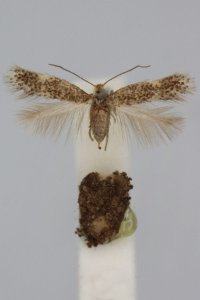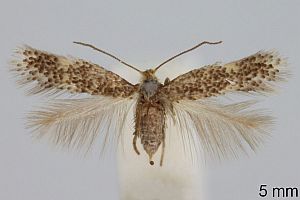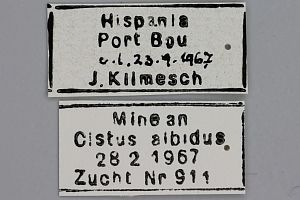

 +11Kontinente:EU
+11Kontinente:EU3. Biologie
3.1. Nahrung der Raupe
- [Cistaceae:] Cistus monspeliensis (Montpellier-Zistrose)
- [Cistaceae:] Cistus salviifolius [= Cistus salviaefolius] (Salbeiblättrige Zistrose)
- [Cistaceae:] Cistus creticus [= Cistus incanus sensu auct.] (Kretische Zistrose, Graubehaarte Zistrose)
- [Cistaceae:] Cistus albidus (Weißliche Zistrose)
- [Cistaceae:] Cistus ladanifer ??? (Lack-Zistrose ???)
- [Cistaceae:] Cistus laurifolius ??? (Lorbeerblättrige Zistrose ???)
Nieukerken (1983) stellte im Rahmen seiner Erstbeschreibung von P. pseudocistivora fest: "Host plants: With certainty bred from Cistus monspeliensis L. and C. salvifolius [sic!] L. Judging from the pointed ovipositor the mines on the hairy C. incanus L. could possibly be attributed to this species." Nieukerken (1983) hatte zu Parafomoria cistivora bemerkt: "Peyerimhoff (1871) also records C. salvifolius [sic!] L. but, as his type series comprises two species, this record could refer to the next species." Im Prinzip zeichnet sich ab, dass P. cistivora an Zistrosen mit wenigstens einseitig unbehaarten Blättern lebt, P. pseudocistivora eher - aber nicht nur! - an beidseitig behaarten Blättern. Insbesondere Cistus monspeliensis wird in Südfrankreich von beiden Arten besiedelt.
Nieukerken (1983) beschreibt die (nicht unterscheidbaren?) Minen von P. cistivora / P. pseudocistivora und grenzt sie von derjenigen anderer Cistus-Minierer ab: “A narrow, often contorted linear gallery, rather long, and very gradually widening. Frass broken linear, filling less than one third width of mine. Mines on C. monspeliensis follow often the leaf margin or a vein (narrow leaves). The mine can easily be distinguished from the other Cistus-feeding species, because it is much longer and liear throughout. The egg is deposited on the leaf upperside and its form is possibly diagnostic: the egg-scales on leaves of monspeliensis are flat but egg-scales which are higher than wide have been observed on C. incanus.”
Weiter: “Mines of the above described type have been reared from: on Cistus monspeliensis: Spain, France, Italy, Corsica, Sicily, Tunisia and Dalmatia; on C. salvifolius [sic!]: Spain, France, Italy, Corsica, Sardinia, Sicily and Dalmatia; on C. incanus Corsica, Sicily, Tunisia, Dalmatia and Palestina; on C. ladanifer from Portugal and on C. laurifolius from Spain.” Nachdem von Korsika, Italien und Kroatien (Dalmatien) bisher nur P. pseudocistivora bekannt wurde, dürften die entsprechenden Minenfunde dort alle zu dieser Art gehören. Das bestätigt Cistus creticus [= Cistus incanus sensu auct.] als Nahrungspflanze von P. pseudocistivora.
Nieukerken (1983) weist darauf hin, dass die Angabe zu Cistus albidus bei Hering (1936) sich in Wirklichkeit auf die erst später beschriebene Parafomoria liguricella bezieht. Wenn der oben gezeigte Diagnosefalter von Port Bou (Spanien) in der Klimesch-Sammlung richtig bestimmt ist, dann gibt es für P. pseudocistivora jetzt doch eine Angabe zu Cistus albidus.
4. Weitere Informationen
4.1. Faunistik
Während Parafomoria cistivora auf Portugal, Spanien und Frankreich (ohne Korsika) beschränkt ist, ist P. pseudocistivora nicht nur aus den gleichen 3 Ländern, sondern auch von Korsika, Italien, Kroatien, Griechenland, Malta, Nord-Afrika und dem Nahen Osten bekannt.
(Autor: Erwin Rennwald)
4.2. Typenmaterial
Van Nieukerken (1983: 461-462): “Holotype ♀: FRANCE: Cannes, Cistus monspeliensis, iii. e.l. 2.x.1890, no. 80503 (Walsingham), (genitalia slide 22587; BMNH).
Paratypes: 10 ♂, 10 ♀. FRANCE: 3 ♂, 2 ♀, Cannes Cistus monspeliensis iii, e.l. 4–7.x.18 (Walsingham); 3 ♂, 3 ♀, Cannes, Cistus salviaefolius (sic!), iii, e.l. 30.ix–10.x.1890 (Walsingham) (BMNH); 2 ♂, 3 ♀, Alpes maritimes, Cannes, (Constant) (MNHN; RMNH); 1 ♂, 1 ♀, Cannes, (syntypes of cistivora?) (RMNH); 1 ♂, no data [paralectotype of cistivora] (Peyerimhoff), (MNHN). ITALY: 1 ♀, Ospedaletii, Riv., Cistus salvifolius, e.l. 14.ix.1932, Nr. 3922 (Hering) (MHUB).”
4.3. Literatur
- Erstbeschreibung: Nieukerken, E.J. van (1983): The Cistaceae-feeding Nepticulidae (Lepidoptera) of the western Palaearctic region. — Systematic Entomology 8: 453-478.
- Peyerimhoff, H. de (1871): [Ohne Titel, Brief an den Herausgeber]. — Mittheilungen der Schweizerischen Entomologischen Gesellschaft 3 (8): 409-414. — Digitalisat von Google Books in der Hathi Trust Digital Library: [414].
















